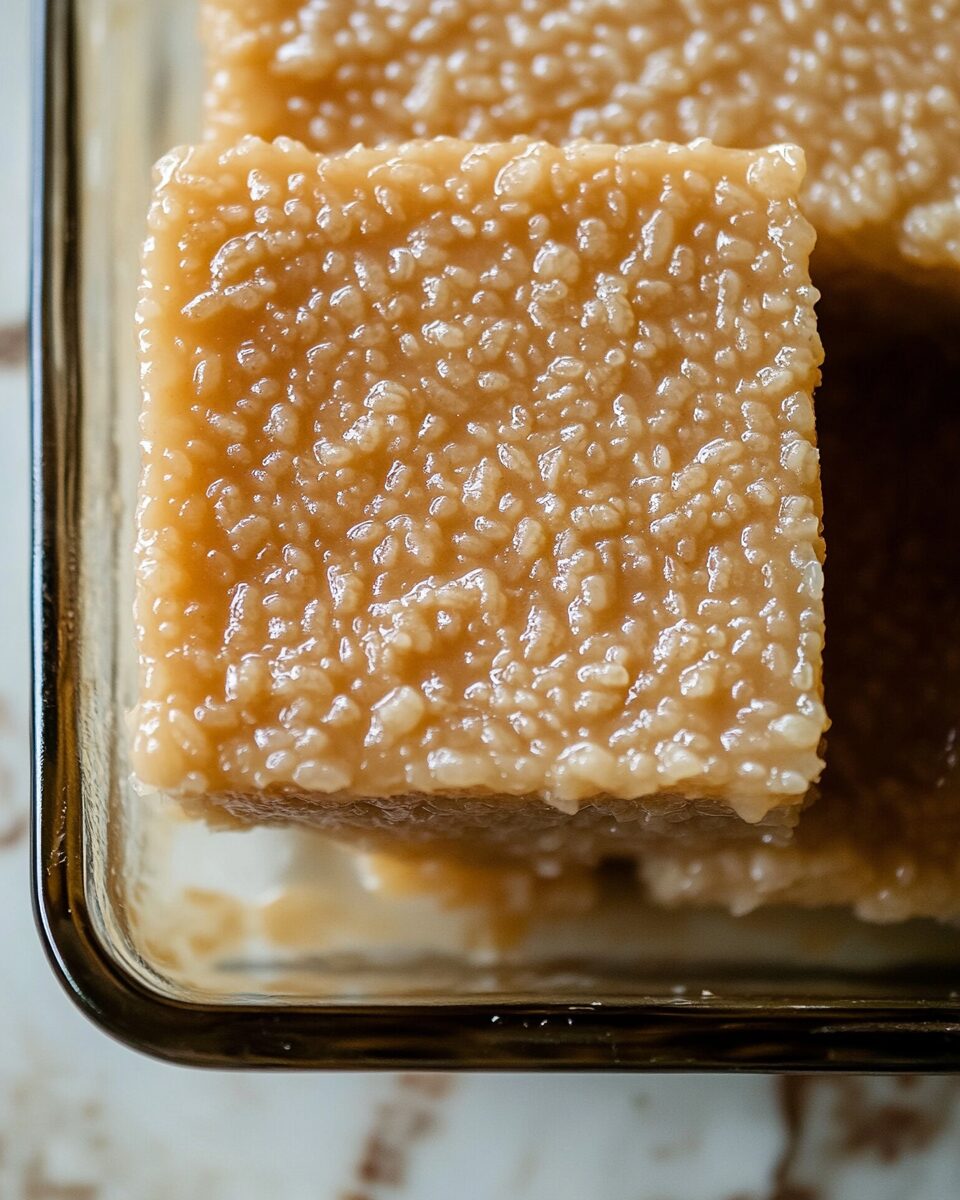Biko is a traditional Filipino dessert made from glutinous rice, coconut milk, and brown sugar. This sweet and sticky rice cake is commonly served during special occasions and gatherings, offering a rich, caramel-like flavor that’s both comforting and indulgent.
FULL RECIPE:
Ingredients
- 4 cups glutinous rice
- 3 cans (14 oz each) coconut milk
- 1½ cups water
- 2½ cups dark brown sugar, packed
- ¼ teaspoon kosher salt
- Butter or coconut oil, for greasing the pan
Directions
- Soak the Rice (Optional): Place the glutinous rice in a large bowl and cover with cool water. Soak overnight to reduce cooking time. After soaking, drain and rinse the rice thoroughly.
- Prepare the Baking Dish: Preheat the oven to 350°F (175°C). Generously grease a 9×13-inch baking dish with butter or coconut oil.
- Cook the Rice Mixture: In a large saucepan, combine the drained rice, 2¼ cans of coconut milk (reserving ¾ cup for later), and 1½ cups of water. Cook over medium heat, stirring frequently to prevent sticking, until the mixture begins to simmer. Continue cooking for about 5-8 minutes until most of the liquid is absorbed.
- Sweeten the Rice: Reduce the heat to low and add 1½ cups of dark brown sugar and ¼ teaspoon of salt to the rice mixture. Stir well and continue to cook for another 5-8 minutes, ensuring the rice is fully cooked and the mixture has thickened.
- Transfer to Baking Dish: Once the rice mixture is ready, transfer it to the prepared baking dish, spreading it evenly.
- Prepare the Topping: In a separate saucepan, combine the reserved ¾ cup of coconut milk and the remaining 1 cup of dark brown sugar. Bring to a boil over medium heat, stirring until the sugar dissolves. Remove from heat and let it cool slightly for 3-5 minutes.
- Bake the Biko: Pour the coconut milk and sugar mixture over the rice layer in the baking dish. Bake in the preheated oven for about 1 hour, or until the topping is bubbling and has thickened.
- Cool and Serve: Allow the Biko to cool slightly before serving, as the caramel topping will be very hot. Serve warm or at room temperature.
Nutrition Facts
- Calories: 420
- Total Fat: 16g
- Saturated Fat: 14g
- Cholesterol: 0mg
- Sodium: 55mg
- Total Carbohydrates: 67g
- Dietary Fiber: 3g
- Sugars: 32g
- Protein: 4g
- Vitamin C: 2mg
- Calcium: 41mg
- Iron: 2mg
- Potassium: 246mg
Cultural Significance of Biko
Biko holds a special place in Filipino culture, deeply embedded in traditions and festivities. This beloved sticky rice cake is often served during significant celebrations such as birthdays, fiestas, and religious occasions like Christmas, New Year, and Holy Week. Its sticky and sweet nature carries symbolic meaning, often representing togetherness, prosperity, and good fortune. Many Filipino families have their own unique way of preparing Biko, making it more than just a dessert it is a representation of familial heritage and tradition. In many households, Biko is served alongside other Filipino delicacies such as bibingka, puto, and suman. It is a staple in “pabasa,” a Lenten tradition where families and communities gather to chant or sing religious verses.
Regional and Modern Variations of Biko
While the classic version of Biko consists of glutinous rice, coconut milk, and brown sugar, different regions in the Philippines have created their own unique versions of this traditional delicacy. One of the most well-known variations is Biko with latik, where crispy, caramelized coconut curds are sprinkled on top, adding a delightful crunch to the dish. Another variation, Ube Biko, incorporates purple yam or ube into the rice mixture, giving the dessert a vibrant purple hue and a subtly sweet and earthy flavor. Pandan Biko is another regional twist that involves infusing the coconut milk with pandan leaves, which results in a fragrant and slightly floral aroma.
Best Ways to Serve Biko
Presentation plays a key role in serving Biko, as the dish is often displayed on banana leaves to enhance its visual appeal and add a subtle earthy aroma. The use of banana leaves also helps prevent the rice from sticking to surfaces, making it easier to handle. Traditionally, Biko is cut into squares or rectangles for easy serving, but some prefer to scoop it directly from a baking dish. Biko is best enjoyed warm or at room temperature, allowing its soft and chewy texture to be fully appreciated. It pairs well with black coffee, hot chocolate, or even a warm cup of salabat, a Filipino ginger tea. Some people like to add a drizzle of condensed milk over the top for extra sweetness, while others garnish it with grated coconut, crushed peanuts, or toasted sesame seeds.
Storage and Shelf Life
Since Biko contains coconut milk, proper storage is necessary to maintain its quality and prevent spoilage. Freshly made Biko is best consumed within the day, as this is when its texture and flavor are at their peak. If there are leftovers, they should be stored in an airtight container at room temperature for up to twelve hours. For longer storage, Biko can be refrigerated for up to three days. When refrigerating, it is important to use a sealed container to prevent the rice from drying out. To reheat, the best method is to steam it for a few minutes, which helps restore its soft and chewy consistency.
Health Benefits of Biko
Coconut milk, another key ingredient, contains medium-chain triglycerides (MCTs), a type of fat that is quickly converted into energy by the body. MCTs are considered to be healthier than other saturated fats and can provide certain metabolic benefits. Additionally, coconut milk is rich in vitamins and minerals, including manganese, which plays a role in bone health and metabolism. One of the advantages of Biko is that it is naturally gluten-free, making it a suitable dessert for those with gluten sensitivities or celiac disease. While glutinous rice does not contain a high amount of dietary fiber, it still contributes to digestive health by promoting slow digestion, which helps maintain stable blood sugar levels.
Why Biko is a Popular Filipino Dessert
Several factors contribute to the lasting popularity of Biko in Filipino cuisine. One of the main reasons is its simplicity and accessibility. The recipe requires only a few basic ingredients, making it an affordable dessert that can be made by anyone with a basic understanding of cooking. Unlike other rice-based treats that require complex preparation methods, Biko is relatively easy to make, which is why it has remained a household favorite for generations. Another reason for its enduring popularity is its longer shelf life compared to other rice cakes. The caramelized topping acts as a natural preservative, helping the dessert stay fresh for a longer period.
Biko in Modern Filipino Cuisine
As Filipino cuisine gains more recognition on the international stage, traditional desserts like Biko are also becoming increasingly popular outside the Philippines. Many Filipino restaurants and bakeries abroad now include Biko on their menus, introducing it to new audiences. The rise of food blogs and social media platforms has also contributed to Biko’s growing popularity, as home cooks and food enthusiasts share their own versions of the dish online. In recent years, chefs and culinary experts have experimented with modern presentations of Biko, incorporating contemporary plating techniques and pairing it with new ingredients.
Conclusion
Biko is more than just a dessert; it is a dish that carries cultural significance, cherished memories, and a deep connection to Filipino heritage. Its simple yet flavorful combination of glutinous rice, coconut milk, and brown sugar creates a satisfying treat that has stood the test of time. From traditional celebrations to everyday indulgence, Biko continues to be a symbol of warmth, togetherness, and Filipino culinary excellence.






